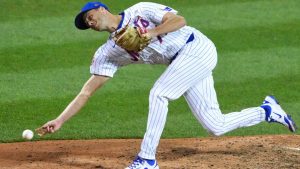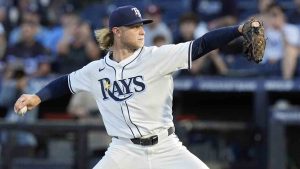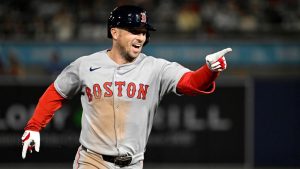DUNEDIN, Fla. – To fully appreciate how well the Toronto Blue Jays are positioned right now, all it takes is a glance back at franchise history.
Since emerging from six years of expansion misery with 11 consecutive winning seasons, the best they’ve done are the three-year bursts of better-than-.500-play from 1998-2000, 2006-2008, 2014-2016 and their current run, which started in 2020 and is only picking up steam.
Four of the six largest contracts ever handed out by the Blue Jays have come in the last three years. This year, their projected player payroll will take them into the Competitive Balance Tax, or CBT, for the first time. The ongoing renovation of Rogers Centre, particularly the second phase next off-season, is part of the revenue growth that underpins the increased spending.
There is ambition in pursuit of new organizational heights.
At the same time, this is also where things get trickiest for the Blue Jays.
The finishing touches in building a World Series winner are always hardest. More guaranteed money on the books means less flexibility each off-season. And the current competitive window could easily close prematurely if the potential roster churn coming in the years ahead isn’t managed right.
Consider the following free-agency eligibilities:
• After 2023 – Matt Chapman, Hyun Jin Ryu, Kevin Kiermaier, Brandon Belt and Anthony Bass,
• After 2024 – Danny Jansen, Yusei Kikuchi, Adam Cimber and Trevor Richards.
• After 2025 – Vladimir Guerrero Jr., Bo Bichette, Cavan Biggio, Chris Bassitt, Jordan Romano, Tim Mayza and Erik Swanson.
• After 2026 – George Springer, Kevin Gausman, Jose Berrios (opt out), Daulton Varsho, Santiago Espinal and Alejandro Kirk.
Combine that with the recent usage of the farm system to augment the club – dealing three of the past five first-round picks since the 2021 trade deadline (Austin Martin for Berrios, Gunnar Hoglund for Chapman and Jordan Groshans for Bass and Zach Pop) plus top prospect Gabriel Moreno (for Varsho) in December – and there could be a cliff to avoid in the distance.
Now, the Blue Jays can simply play out their window, backfill as needed and use the upcoming flexibility to adapt based on what their post-2025 situation dictates. Things change fast, good and bad. Still, without retaining one of, if not both, Guerrero and Bichette, their most important young talents, pushing out their run over the long-term is hard to imagine.
“Let me just say, first of all, that a three-year window, which we feel is easy to identify, is a pretty long window,” Blue Jays president and CEO Mark Shapiro said in a recent interview. “If you were to have signed Bo and Vladdy to a three-year free-agent deal, you wouldn't be talking about them leaving in the first year of the deal, you’d be excited. They're here on a three-year deal and the other contracts are just the normal flow that every single Major League Baseball team goes through in the off-season.
“What I'd say is there's not a reality that we don't consider where what we're doing in the draft last year, what we're doing (in) the draft this year, what we're doing internationally last year, this year, the year before, what we're doing (in) player development on a day-to-day basis and developing players who we may not expect to be impact guys now to become very good players. We can't sustain it without that, regardless of who we sign or who we extend,” Shapiro continued. “The most important thing we do to maintain and keep open a window of contention is identifying, acquiring and developing talent. That's what we have to do. And as far as decisions to extend one or more players or sign new players, that would be an important part of that as well. But the most important part is development and scouting.”
There’s no debate about that, but less clear is which prospects will help turn over the roster and make the Blue Jays a sustainable competitor.
Right now, their farm system is ranked 17th by Keith Law of The Athletic and 22nd by Kiley McDaniel at ESPN. While 20-year-old lefty Ricky Tiedemann is a fast-rising jewel and 21-year-old infielder Orelvis Martinez is a high-risk, high-reward power threat, the waves of talent needed to prevent a dip don’t appear to be in place.
Each draft and international signing period offers opportunity to change that.
But landing franchise cornerstone types is extraordinarily difficult and transitioning them to the majors takes time. Guerrero was signed in 2015, Bichette drafted in 2016 and it wasn’t until 2021 that they became all-stars. Alek Manoah’s rapid ascent is a unicorn – most prospects don’t make it.
As Shapiro himself rightly notes, “I have looked at a large number of five-year projections of rosters throughout a long career, and they are almost comical, usually, from what the reality is.”
“I feel good thinking about the major-league scenario over the next three years, and I feel good about the effort of the scouting and development staff we have in place to find some unexpected surprises and continue to develop the existing players,” Shapiro added. “But projecting rosters out four or five years down the road is almost impossible. We’ll continue to do that, but we’ll also just refresh that every six months.”
That reality only adds to the current window’s longer-term volatility.
Minus a long-term extension for Guerrero and/or Bichette, the Blue Jays will eventually have to weigh the opportunity cost of a competitive run in 2025 versus the risk of losing them for nothing but a compensatory draft pick at season’s end.
More decisions will have to come that off-season, depending on whether the dynamic duo can be re-signed, if commensurate replacements can be acquired either in trade and free agency and what internal pieces may be arriving then.
Should Guerrero and Bichette end up walking, the viability of contention moving forward takes a major hit – even with money freed to pursue other players. Berrios then surely weighs his post-2026 opt and a decision of how to leverage the remaining contractual control of Manoah, eligible for free agency after the 2027 season, becomes a necessity.
Though that may seem like a Future Blue Jays problem, it’s a Present Blue Jays issue, too, because with each passing year it becomes less likely for Guerrero and Bichette to be bought out of free agency.
The $33.6-million, three-year extension signed by Bichette to avoid arbitration earlier this month may be a sign that both parties plan to put off a bigger deal for now, at least.
Guerrero, having banked $7.9 million last year with another $14.5 million due this year, is looking at a total haul ranging from $50-$60 million in his final two trips through arbitration. With $70-$80 million earnings essentially locked in and the open market nearing, the risk in playing things out to free agency decreases for the player and increases for the club.
An especially robust free-agent market this winter is another factor and there’s a cautionary tale in how the New York Yankees had to fend off aggressive suitors to retain Aaron Judge and the Boston Red Sox misjudging Xander Bogaerts’ market before rushing to pay Rafael Devers.
The trend for teams with elite young talents has been to lock up them up early.
No deal was more creative – and complex – than the one Julio Rodriguez and the Seattle Mariners agreed to last summer, which guaranteed $210 million with club and player options that can take the total up to $470 million.
In putting together the framework, Mariners president of baseball operations Jerry Dipoto sought to create “a contractual model that allowed him to achieve what he should rightly achieve while we get the opportunity to keep him with the Mariners over the course of what we think is going to be a long and exciting career.”
“We did a deal for Julio that we thought represented Julio and that was important, otherwise we just weren't going to get it done,” Dipoto added later. “I don't think a simple here's a base contract with a couple of options attached was going to work in this case. On both sides of the table the belief was that we were dealing with the potential for something extraordinary because of his personality and a lot of his gifts off the field in addition to what he does on the field.”
Rodriguez, a dynamic middle-of-the-diamond player, isn’t a direct comp for Guerrero, and only somewhat so for Bichette. The Blue Jays also employ a more measured managerial approach than their expansion cousins, although what they can take from the Mariners is the idea of finding a deal that represents their young stars within their organizational framework.
So, rather than pursing the career-long deals signed by Rodriguez, Fernando Tatis Jr., or Wander Franco in recent years, a mid-term model akin to the $120-million, six-year deal the Red Sox gave Bogaerts in 2019 ahead of his walk year seems more of a Blue Jays fit.
Cleverly, that contract assured Bogaerts of generational earnings with the chance to re-enter the market ahead of his age-30 season through an opt out (which he exercised). The trade-off was the Red Sox getting three of the star shortstop’s prime free-agent years without an extended commitment.
Bogaerts ended up signing a $280-million, 11-year deal with the San Diego Padres in December, which was a better outcome for him than his former club. The Red Sox did mitigate their financial and on-field risk, although an antidote for the fan venom remains lacking.
The question for the Blue Jays, then, assuming the approach fits their vision, is can they tempt Guerrero or Bichette with a similar structure in place of a longer-term deal?
A potential model for Guerrero, for instance, could be a seven-year deal that exceeds the annual average value of $31 million in first baseman Miguel Cabrera’s $248-million, eight-year contract with the Detroit Tigers, with an opt-out after five years. Like with Bogaerts, the Blue Jays would get three free-agent years while Guerrero could re-enter the market for his age 30 season.
Even if Guerrero stayed the full seven years, another big contract could still be out there for him. Two first basemen heading into their age-32 seasons have done very well on the market in recent years: Freddie Freeman got $162 million over six years from the Los Angeles Dodgers and Paul Goldschmidt $130 million over five years from the St. Louis Cardinals.
A similar mid-term model is much harder to envision for Bichette, complicated by the guarantee already in place and mega-contracts recently signed by shortstops, Bogaerts included. Being a year older than Guerrero, an opt-out after three years would leave him re-entering the market at 31, an age that has impacted some free agencies.
For those reasons, it feels like for now the Blue Jays would have to either buy out his entire career or settle for the three years they already have and see what happens when free agency arrives.
More is preferable to less with both players, especially given that the Blue Jays expect to have a fully renovated Rogers Centre in time for the 2024 season they’ll want to leverage.
They’re already spending to levels that could support those types of contracts, with FanGraphs’ RosterResource page, estimating their luxury-tax payroll, which factors in 40-man roster spending, player benefits, etc., for 2023 at $250.5 million.
That’s not only past the first CBT threshold of $233 million but also approaching the second of$253 million. For a first-time payor like the Blue Jays, any overage above the first line is taxed at 20 per cent, and anything above the second mark charged at 32 per cent.
The Blue Jays are intaking more money from central revenue sources like national TV contracts and are in the market for a jersey-patch sponsor, “but the primary driver of increased revenue will be from the premium spaces created in Phase 2 of the renovation project,” said Shapiro, who added that “our revenues throughout all of the major sources are growing.”
Shapiro again credited “an unprecedented level of support from ownership” at Rogers Communications Inc., which also owns this website, for keeping the club’s plan on track through the pandemic interruptions.
“The market is an incredible market,” he said. “The growth potential and the business is there if the team can build a sustainable winner.”
Shoehorning the second phase of the renovation into a five-month period will be the primary off-field challenge in the months ahead, according to Shapiro. While a third or fourth phase of renovation down the road is possible, once the next stage is completed the team will have to “pull back and spend time and energy to think about, OK, now that we've addressed the mid-term needs of the stadium, what does the long-term look like?”
“That's going to take more than me, (that’s) a few people spending a couple of years exploring what the alternatives are and do you continue to renovate Rogers Centre, do you undertake a much larger renovation of Rogers Centre or do you build a new stadium where Rogers Centre is located, or do you build a new stadium somewhere else?” said Shapiro. “Researching all those things. I'm talking about 15 years from now, but someone has to spend the time thinking about that. That's going to be an important lever for the team. Other than that, it will be just continuing to ensure that we never get too stagnant and we're continuing to challenge ourselves to grow, develop and improve on a daily basis and elevate what we have in place. But it will be much easier to do from that place than it is to build.”
The same applies to the current competitive window, completely wide open and beginning to shut at the same time.






